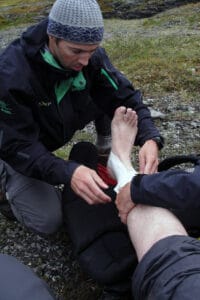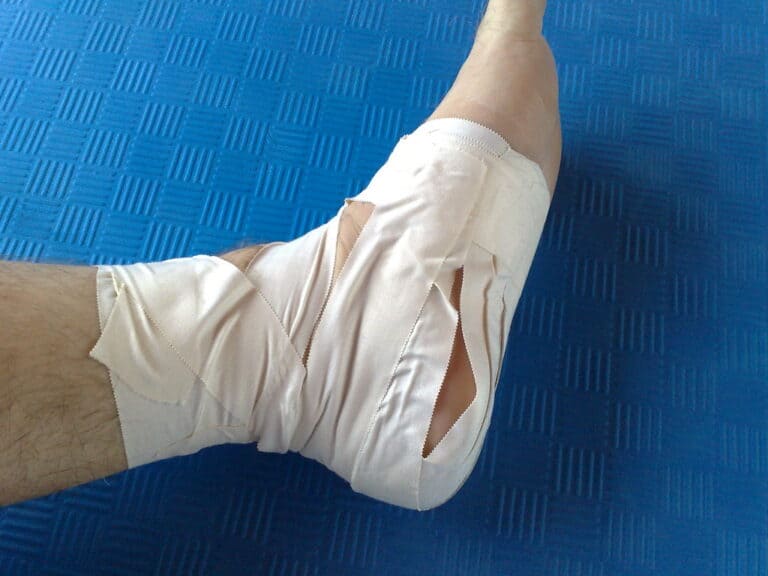Trail running is a thrilling outdoor activity that allows you to connect with nature while getting a great workout. However, the uneven terrain and unpredictable surfaces can put extra strain on your ankles, increasing the risk of sprained ankle and injuries. To mitigate this risk, learning how to tape an ankle before trail running is crucial. Proper ankle taping provides additional support, stability, and helps reduce the chances of overuse injuries. In this guide, we’ll walk you through the steps of ankle taping, ensuring you can hit the trails with confidence and minimize the risk of injury.
How to Tape an Ankle Before Trail Running
Ankle Sprains and Injuries
Ankle sprains are one of the most common injuries experienced by trail runners. They occur when the ligaments surrounding the ankle joint are stretched or torn, often due to a sudden twist or roll of the foot. Taping can help stabilize the ankle, providing extra support to prevent these injuries.

Ankle Stability for Trail Running
The ankle joint is a complex structure comprised of bones, ligaments, and tendons. When running on uneven terrain, especially in technical terrain, ankle stability is crucial for maintaining balance and preventing injury. Proper taping technique can enhance this stability.
Engage Foot Gently
Before applying the tape, it’s important to engage your foot gently to ensure it’s in a neutral position. This means your toes should be facing forward, and there should be no excessive tension or strain in the ankle joint.
Materials You’ll Need
Athletic Tape
Medium width athletic tape is the preferred choice for ankle taping. It provides the right balance of support and flexibility needed for trail running.
Stirrup Straps
Stirrup straps are essential for creating the necessary tension and support around the ankle joint. They form a crucial part of the taping approach.

Anchor Strips
Anchor strips help secure the tape in place, ensuring it doesn’t shift or come loose during your run.
Kinesiology Tape (Optional)
While not necessary, kinesiology tape can be used in addition to traditional athletic tape for added support and blood flow stimulation.
Step-by-Step Guide to Ankle Taping
1. Preparing the Ankle
Start by cleaning the ankle and removing any excess dirt or oils. If you have leg hair, consider shaving the area where the tape will be applied to ensure proper adhesion.
2. Anchoring the Tape
Begin with a circular anchor strip around the lower leg, just above the ankle bone. This will serve as the starting point for the tape job.
3. Applying the Stirrup Straps
Start the stirrup strap slightly behind the ankle bone and wrap it under the arch of the foot. Continue by ankle joints wrapping directly on the opposite side of the ankle and secure it on the anchor strip.
4. Creating Supportive Overlays
Continue wrapping the tape around the ankle, providing stability by overlapping the previous layer. This should be done in a figure-eight pattern, ensuring even pressure and support.
5. Full Range of Motion
Ensure that the ankle maintains a full range of motion while applying the tape. It should feel snug but not constricting, allowing for natural movement.
6. Checking for Comfort
Before hitting the trail, ensure that the tape job is comfortable and doesn’t cause any discomfort or pain. Adjust as necessary to achieve the right balance of support.
Additional Tips and Considerations
– Proper Form and Balance Work: In addition to taping, focus on maintaining proper form and incorporating balance exercises into your strength training routine.
– Use Waterproof Tape: Ideally, use waterproof tape to ensure it stays in place even if you encounter water during your trail run.
– Reassess Before Race Day: Different athletes may require different taping methods. Experiment with what works best for you before race day.
By following this taping approach, you’ll provide your ankles with the stability they need for a safe and enjoyable trail running experience. Remember, taping is a preventative measure that complements your natural feedback cycles, reducing the risk of compensation injuries and allowing you to push your limits without the fear of new injuries or worse sprains. But consult a doctor or physical therapist if you need to. Happy trails!
- How Do I Keep My Feet Dry While Trail Running 7 Top Tips
- How Do You Carry Your Phone While Trail Running
- How Do You Treat A Sprained Ankle On A Trail
- How Does Trail Running Improve Your Balance
- How Far Is An Ultra Marathon
- How Long Can The Average Person Run
- How Long Do Trail Running Shoes Last
- How Many Lumens For Trail Running
- How Often Should You Trail Run
- How To Avoid Getting Ticks
- How To Become A Trail Running Coach
- How To Break In Trail Running Shoes
- How To Carry Water On A Run
- How To Choose Trail Running Shoes
- How To Clean Trail Running Shoes
- How To Deal With Navigational Challenges On Trails
- How To Eat And Drink While Trail Running
- How To Find Trail Running Routes
- How To Get Sponsored For Trail Running
- How To Improve Your Trail Running
- How To Lace Trail Running Shoes
- How To Prepare For Your First Trail Race
- How To Prevent Cramps When Running
- How To Set And Achieve Trail Running Goals
- How To Start Trail Running
- How To Tape An Ankle Before Trail Running
- How To Train For Mountain Trail Running
- How To Train For Trail Running Without Trails 11 Great Tips
- How To Train For Trail Running
- How To Use Poles When Trail Running
- How To Warm Up Before A Trail Run
- How To Wear An Armband While Running
- How Trail Running Helps In Body Toning
